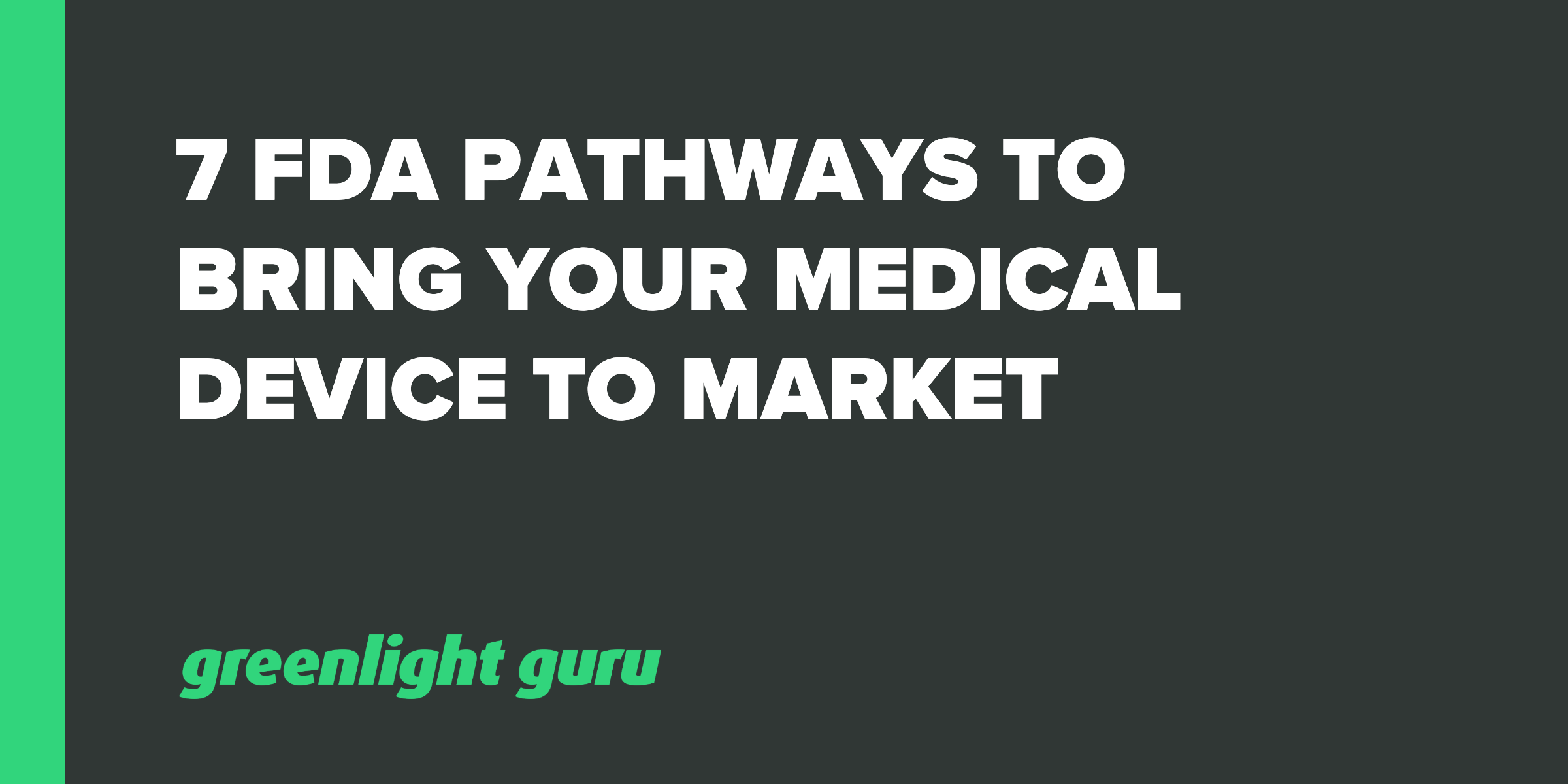
Anyone reading this who is planning to launch a medical device in the U.S. has likely heard of the 510(k) process. Those of you working on novel or high risk devices are may be familiar with the PMA and De Novo pathways. These three options are most commonly used by device companies.
Did you know that there are actually seven major pathways that can be used to bring a medical device to market?
So many people assume the 510(k) route is right for them because it is what everyone else does. I am here to tell you that is not always the case, and one of the other pathways might actually be better for your company.
It is very important that you are aware of the various pathways and understand the pros and cons of each. Don’t look at the regulatory process as a series of hoops to jump through. Instead, focus on creating a regulatory strategy for your specific device that sets you apart from your competition.
The 7 major pathways to market in the U.S. include:
-
Premarket Notification 510(k)
-
Premarket Approval (PMA)
-
De Novo
-
Humanitarian Device Exemption (HDE)
-
Custom Device Exemption (CDE)
-
Expanded Access Program (EAP)
-
Product Development Protocol (PDP)
Let’s dive into each one of these seven FDA pathways to entering the US market in greater detail, so you can understand which is the best option for your medical device.
FREE DOWNLOAD: Click here to get our 5 tips for planning a competitive regulatory strategy.
1. Premarket Notification 510(k)
The Premarket Notification 510(k) pathway is the most common route taken when launching a medical device. Almost all Class II devices and certain Class I devices will require a 510(k).
The purpose of a 510(k) submission is to provide the FDA with documented evidence showing that your medical device is substantially equivalent in terms of safety and effectiveness to a predicate device.
A predicate device is one that is already legally marketed and shares the same intended use and technological characteristics as your device. You are required to compare and contrast your device with the predicate by summarizing information from your design controls process, such as design features and verification testing.
The FDA typically processes 510(k) applications in 30-90 days. Depending on the robustness of your initial application, there may be a period of back and forth discussions, of which can delay the process. It is important to plan ahead and provide all appropriate documentation at the time of initial submission.
2. Premarket Approval (PMA)
Class III devices, and any device that cannot provide substantial equivalence to a Class I or Class II device through the 510(k) process, must use the Premarket Approval (PMA) pathway.
The PMA process is the most involved as scientific evidence, typically in the form of a clinical trial, is needed to prove the safety and effectiveness of your device.
The FDA will either approve or reject the application within 180 days. The different steps of the review process include:
-
FDA staff will determine completeness through an administrative and limited scientific review
-
FDA staff will conduct an in-depth scientific, regulatory, and Quality System review
-
An advisory committee will review and offer any recommendations. a
-
Any final deliberations will occur and the FDA will document and notify you of their final decision
Although the medical device approval process sounds intimidating, it is the right option for you if you have a high risk, Class III device.
3. De Novo
If you are developing a lower risk, “novel” device and struggling to find a predicate, the De Novo pathway might be the best option for you.
The De Novo pathway has actually been around since 1997 but many people do not know about it since it is not very commonly used. Companies that do not qualify for 510(k) clearance, due to the fact that they cannot provide substantial equivalence to a device on the market, should learn more about the De Novo pathway.
Since comparison to a predicate is not needed, companies have a “blank canvas” when it comes to labeling and can set a standard that may give them a competitive advantage over others. One of the key things to remember about the De Novo pathway is you must show your device presents low to moderate risk through a robust risk mitigation strategy.
4. Humanitarian Device Exemption (HDE)
The Humanitarian Device Exemption (HDE) pathway is for devices that are intended to treat or diagnose conditions or diseases that affect small or rare populations.
This pathway involves a two-step process. The FDA must grant a Humanitarian Use Device (HUD) exemption and the device company must then submit an HDE application to the appropriate review center.
Another important requirement is that there cannot be another comparable device on the market that shares the same intended use. The FDA will consider the following when determining if there are comparable devices on the market:
-
The device's indications for use and technological characteristics.
-
The patient population to be treated or diagnosed with the device.
-
Whether the device meets the needs of the identified patient population.
Part of the rationale for providing this pathway is there may not be a large enough patient population with clinical data to satisfy regular FDA requirements of safety and efficacy. Since these devices may be very crucial to patients with rare conditions, the FDA put it in place to do a proper review to determine if the device can be sold.
5. Custom Device Exemption
Are you developing a custom device for a specific patient? If so, your device falls under the Custom Device Exemption (CDE) pathway and must meet a very narrow set of criteria.
The device must be created or modified in order to comply with the order of an individual physician or dentist, typically in the form of a prescription. Not only must the clinician order the device, but it must also be used in the normal course of the professional practice of that physician or dentist.
The product should be specifically designed to treat a unique pathology or physiological condition that no other device is domestically available to treat. It must be assembled from components or manufactured and finished on a case-by-case basis to accommodate the unique needs of the patient.
The FDA even states that companies are limited to no more than 5 units per year of a particular device type.
CDE devices are exempt from PMA or 510(k) submission process but the company still needs to comply with the following regulations:
-
Design Controls (21 CFR Part 820)
-
Medical Device Reporting (21 CFR Part 803)
-
Labeling (21 CFR Part 801)
-
Corrections and Removals (21 CFR Part 806)
-
Registration and Listing (21 CFR Part 807)
6. Expanded Access Program (EAP)
The Expanded Access program, often referred to as the compassionate use or emergency use provision, is fairly self-explanatory.
It allows an investigational device to be used, outside of a clinical trial, in situations where a seriously ill patient has few if any alternatives.
Although there are often ethical considerations, it may be appropriate to evaluate this option as a way to get early feasibility data for high-risk devices, especially when suitable animal models are unavailable. Like the HDE, this data could then be used to expand the label in the future.
Expanded access may be an appropriate pathway for you to choose when all the following apply:
-
Patient has a serious disease or condition, or whose life is immediately threatened by their disease or condition.
-
There is no comparable or satisfactory alternative therapy to diagnose, monitor, or treat the disease or condition.
-
Patient enrollment in a clinical trial is not possible.
-
Potential patient benefit justifies the potential risks of treatment.
-
Providing the investigational medical product will not interfere with investigational trials that could support a medical product’s development or marketing approval for the treatment indication.
7. Product Development Protocol
The Product Development Protocol (PDP) is a subset of the PMA process that allows for another pathway for companies with devices in which the technology is well established in the industry.
This pathway allows the company to come to an early agreement with the FDA about how safety and effectiveness of the device will be shown. The two parties are essentially creating a contract that describes design and development activities, including the outputs of these activities, and acceptance criteria for these outputs.
The company can follow the plan on their own time and report back to the FDA on the agreed upon milestones. At the end of the process, the company is considered to have “completed” a PDP, which gives them an “approved” PMA.
FREE DOWNLOAD: Click here to get our 5 tips for planning a competitive regulatory strategy.
Final Thoughts
So much work goes into the design and development of your product. You want to get that product to market as quickly as possible so it is important to not overlook the creation of a robust regulatory strategy.
You shouldn’t wait until the end of a project and chose a regulatory path because “this is what I’ve heard of” or “this is the most popular pathway.”
Spend some time understanding the different regulatory pathways and choose the one that is best for you. Not only will it help you get to market faster, but it may be able to yield a competitive advantage over the competition.
Looking for a design control solution to help you bring safer medical devices to market faster with less risk? Click here to take a quick tour of Greenlight Guru's Medical Device QMS software →
Tom Rish is a Medical Device Guru at Greenlight Guru who works with customers to utilize their QMS software to build safer products on expedited timelines. He is a Biomedical Engineer who began his career developing implant and instrument systems in the orthopedic industry. He enjoys helping customers successfully...
Related Posts
How to Use the De Novo Pathway for your Medical Device
3 Medical Device Security Challenges (and Solutions)
What is the True Cost of Poor Quality for Your Medical Device Company? (Free Infographic)
Get your free resource
5 Tips for a Competitive Regulatory Strategy











